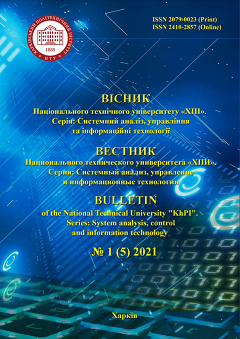MODELLING SEMANTIC KERNEL OF WEB RESOURCE
DOI:
https://doi.org/10.20998/2079-0023.2021.01.08Abstract
The article presents an attempt to describe mathematically the effect of the semantic kernel of a web resource on the Internet. In accordance with the theory of marketing, the product that we want to sell on the network is characterized by the following basic properties: price, time and place. In other words, a potential buyer wants to receive a given product in the right place at a given time. To satisfy this need, it is necessary to use the classic component of marketing, product promotion. However, this component is now becoming a fully virtual instrument. This tool functions in a hypertext, video and image environment. Therefore, the user analyzes the meaning of these elements in order to get the desired product. The results of web projects carried out in this area indicate the emergence of a new phenomenon, which reflects the main meaning of virtual promotion – this is the semantic core. The core is a short annotation of the main properties of the product, its location and time of appearance. Therefore, the purpose of this article is both a presentation of a new object of research and a mathematical description. It is assumed that the semantic core is formed on the basis of natural language terms. In other words, the semantic core is a set of keywords that are grouped by meaning. We propose to use data mining approaches for clustering to group terms. The classic clustering method at the moment is k-means. The article presents a model of the semantic core based on this method. This method and its distance function are considered as the second stage of web content processing. At the first stage, web content is converted into a semantic web. However, the k-means technique has significant drawbacks when modeling the semantic core. Therefore, in the development of this idea, the work shows an alternative way to modeling the kernel. As an alternative approach, the construction of clusters based on the concept of maximum flow is considered. This approach has the significant advantage that the type of links in the semantic network overlaps with the type of distance function in this method. As a result, on a real web project, the effect of the connection between the semantic core model and the level of new users of the web resource was demonstrated over the past five years.
Keywords: semantic kernel, keyword, k-means, max flow.
References
Godlevsky M., Orekhov S., Orekhova E. Theoretical Fundamentals of Search Engine Optimization Based on Machine Learning. CEUR WS. USA, 2017. vol. 1844, pp. 23–32.
Orekhov S., Malyhon H., Stratienko N., Goncharenko T. Software Development for Semantic Kernel Forming. CEUR WS. USA, 2021. vol. 2870. pp. 1312–1322.
Amit K. Artificial Intelligence and Soft Computing. Behavioral and Cognitive Modeling of the Human Brain. USA: CRC Press LLC Publ., 2000. 788 p.
Konnov I. V., Kashina O. A., Gilmanova E. I. Reshenie zadachi klasterizazii metodamai optmizazii na grafah [Solution of clusterization problem by graph optimization methods]. Uchenye Zapiski Kazanskogo Universiteta. Seriya Fiziko-Matematicheskie Nauki [Scientific bulletin of Kazan University. Physical and Mathematical Series]. Kazan, Kazan University Publ., 2019, issue 161, no. 3, pp. 423–437.
Cherenkov I, Orekhov S. Approach for extracting events from news stream. Eastern–European Journal of Enterprise Technologies. 2013. vol. 1, no. 4 (61), pp. 62–64.
Preisach C., Burkhardt H., Schmidt-Thieme L, Decker R. Data Analysis, Machine Learning and Applications. Germany: SpringerVerlag Publ., 2008. 703 p.
Han J., Kamber M, Pei J. Data Mining Concepts and Techniques. USA: Morgan Kaufmann Publ., 2012. 740 p.
Shumeyko А.А., Sotnik S.L. Intellektualnuy analyz dannuh. Vvedeniye v Data Mining [Intelligent data analysis. Introduction in Data Mining]. Dnepr: Belaya Publ., 2015. 223 p.
Willams U. Т., Lans D. N. Metodu ierarhicheskoy klassifikazii [Methods of hierarchical classification]. Statistical methods of computer machine. Moscow: Nauka Publ., 1986. pp. 269–301.
Venugopal K.R., Srinivasa K.G. and Patnaik L.M. Soft Computing for Data Mining Applications. Germany: Springer Publ., 2009. 354 p.
Witten Ian H., Frank E. Data Mining. Practical Machine Learning Tools and Techniques. USA: Morgan Kaufmann Publ., 2009. 558 p.
Duran B. Klasternuy analiz [Cluster analysis]. Moscow: Statistica Publ., 1977. 128 p.
Zamyatin A. V. Intelektualnuy analiz dannuh. Uchebnoe posobie [Intelligent data analysis: tutorial]. Tomsk: Tomsk state university Publ., 2016. 120 p.
Downloads
Published
How to Cite
Issue
Section
License
LicenseAuthors who publish with this journal agree to the following terms:
- Authors retain copyright and grant the journal right of first publication with the work simultaneously licensed under a Creative Commons Attribution License that allows others to share the work with an acknowledgement of the work's authorship and initial publication in this journal.
- Authors are able to enter into separate, additional contractual arrangements for the non-exclusive distribution of the journal's published version of the work (e.g., post it to an institutional repository or publish it in a book), with an acknowledgement of its initial publication in this journal.
- Authors are permitted and encouraged to post their work online (e.g., in institutional repositories or on their website) prior to and during the submission process, as it can lead to productive exchanges, as well as earlier and greater citation of published work (See The Effect of Open Access).


